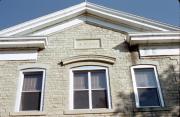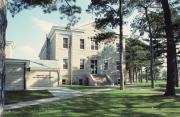Property Record
220 N BEAUMONT
Architecture and History Inventory
| Historic Name: | Crawford County Courthouse |
|---|---|
| Other Name: | Crawford County Courthouse |
| Contributing: | |
| Reference Number: | 3896 |
| Location (Address): | 220 N BEAUMONT |
|---|---|
| County: | Crawford |
| City: | Prairie du Chien |
| Township/Village: | |
| Unincorporated Community: | |
| Town: | |
| Range: | |
| Direction: | |
| Section: | |
| Quarter Section: | |
| Quarter/Quarter Section: |
| Year Built: | 1867 |
|---|---|
| Additions: | 1931 1896 |
| Survey Date: | 1976 |
| Historic Use: | courthouse |
| Architectural Style: | Italianate |
| Structural System: | |
| Wall Material: | Limestone |
| Architect: | |
| Other Buildings On Site: | |
| Demolished?: | No |
| Demolished Date: |
| National/State Register Listing Name: | Crawford County Courthouse |
|---|---|
| National Register Listing Date: | 3/9/1982 |
| State Register Listing Date: | 1/1/1989 |
| National Register Multiple Property Name: | County Courthouses of Wisconsin Thematic Group |
| Additional Information: | A 'site file' exists for this property. It contains additional information such as correspondence, newspaper clippings, or historical information. It is a public record and may be viewed in person at the Wisconsin Historical Society, State Historic Preservation Office. Constructed in 1867 in the center of an expansive tree-filled lawn, the Crawford County Courthouse combines the distinctive rectilinear formality of the Italianate style with the warm color and rough texture of Dolomitic limestone. Although later additions (1896, 1931) have been appended to the original structure, the nearly cubic dimensions and tall proportions of the 1867 courthouse are still apparent. Five bays wide across the front (west) facade and six bays long, the original wing rises two stories from a raised basement and culminates in a low-pitched hip roof. Crisply framed by smooth stone quoins of alternating length and crowned with an emphatic cornice above an unornamented frieze, the building is dominated by a central gabled pavilion which projects slightly from the main facade. Gable returns and stone quoins articulate the pavilion, underscoring its symbolic role as an entry to the building. A short flight of stairs leads to the central door and a stone architrave, with segmental hood, surrounds it. Above the door, a segmental stone hood surmounts the second story window, and above that, a date stone ornaments the gable end. Symmetrically disposed throughout the composition, tall, segmentally arched windows are capped with smooth stone lintels and rest on stone sills. A stone course separates the upper stories from the raised basement and entry to the basement is gained through a door beneath the exterior flight of stairs. A two-story limestone jail, constructed in 1896 (and recently attached to the original courthouse by a one-story limestone-veneered wing) has a bracketed central gable, echoing the courthouse, with symmetrical fenestration and heavy stone lintels and sills. A skillfully executed east wing, constructed in 1931, projects south from the original courthouse, complementing its massing and materials, while subtly evoking a distinctly Georgian quality. A fully pedimented central pavilion, with four colossal pilasters and a central round headed window, rises two stories on the south facade. Although symmetrical in its fenestration, the flat headed rectangular windows of the east wing are less tall in proportion and, extending for seven bays on the east facade the addition has the simple planar quality of the Georgian Revival. Yet while more than half a century separates their construction dates, the 1931 addition shares the gentle dignity, quiet repose, and limestone exterior of the original structure. Although the 1867 wing retains the original tin ceiling, the interior features of both units are unprepossessing. But the most dramatic feature of the building is hidden in the basement of the old structure where the original jail is well-preserved. Built in catacomb-like fashion, with low vaulted ceilings, thick limestone walls, and poor natural illumination, the jail is composed of a series of squat cells with heavy iron bars and doors. A lower level on the north side of the basement contains five cells, each measuring seven feet in length by five feet in width by seven feet in height. Two solitary confinement cells are located on the south side of the basement, and a single cell, measuring only three feet wide, is located in the central corridor. The only alteration has been the addition of a concrete floor. Architectural Significance: Pristine in its formal rectitude and enriched by the warmth of its dolomite walls, the Crawford County Courthouse is a distinguished example of the Italianate style in public architecture. Built in 1867 for $23,000, and constructed with stone hauled from the village of Bridgeport, the chastely rectilinear design conveys at once a sense of grandeur and restraint. The 1896 jail and 1931 east wing addition are surprisingly compatible in scale, massing and material despite their varied dates of construction and echoes of different styles. In the basement of the west wing, the historic county jail is a significant and rare example of a mid-nineteenth century penal facility, existing today in a surprisingly good state of preservation. The Crawford County Courthouse is a dominant visual landmark, situated on a spacious lawn and towering above a nearby residential neighborhood in the center of Prairie du Chien. Historical Significance: Serving since 1867 as the administrative and judicial center of one of Wisconsin's original counties, the Crawford County Courthouse is an enduring historical landmark closely associated with the political and governmental affairs of the region. But the significance of the courthouse goes beyond its remarkable tenure: The Courthouse also contains a mid-nineteenth century jail, a rare remnant of civil authority and criminal justice from the last century and a tangible link to the earliest history of Crawford County. Established in 1818 as one of three territorial counties which comprised present-day Wisconsin, Crawford County's history preceded statehood by thirty years. Thus, when the "new" courthouse was erected in Prairie du Chien in 1867, it was not the first such structure on the site. Nevertheless, current county buildings were so "unsafe and untenable" by 1866, that the county court had abandoned them. (See Bib. Ref. B). Appointing a building committee composed of H. Dousman, H. Beach and William Dutcher, in 1866, the county board purchased the entire block around the site of the old structure, raised fifteen thousand dollars in taxes (see Bib. Ref. A), and received ten thousand dollars from the "businessmen" of the village of Prairie du Chien who hoped a new structure would enhance the community. (See Bib. Ref. B). On June 23, 1866, authority was given to proceed with the construction, plans were approved in September and Michael Menges was chosen to build the structure with stone hauled from the nearby village of Bridgeport. (See Bib. Ref. A). Although local historians claim the new courthouse was built upon the foundation of the previous structure (constructed in 1843) and that the basement prison therefore predates statehood, the claim has not been verified. County Board records for 1866 clearly specify the county's approval of a new courthouse and jail, and on June 4, 1867 the Board voted to sell the old jail at auction. (See Bib. Ref. D). Moreover, one county history reports that "during the first few years" of the new building's life, "the lower or half basement was used for a jail and sheriff's residence, " (see Bib. Ref. A) failing to mention any previous jail on the site. Regardless of construction date, however, the old Crawford County jail is historically significant as one of the oldest and best preserved penal facilities from the mid-nineteenth century history of Wisconsin. Used as a jail until 1896, the facility reflects an era when prison conditions were rarely more than dark and dank cells incongruously housed only a short distance from the grandeur of the courtroom - and in Prairie du Chien, located in the basement of the village's most prestigious building. The proximity of the dungeon-like jail to the second floor court was a visible reminder in the nineteenth century Crawford County of the swift process of justice and the intricate connection between the judges and the judged. (See Bib. Ref. D). Not until 1896 did a new and separate building replace the basement jail. Now used for storage, the jail - like the entire Courthouse building - has been in continuous service to the citizens of Crawford County and indelibly reflects the long political history of the county. |
|---|---|
| Bibliographic References: | A. John G. Gregory, A History of Old Crawford County (Chicago: S. J. Clarke, 1932) pp. 258-259. B. Prairie du Chien Courier, June 21, 1866 (Volume XIV, No. 28) n.p. C. Crawford County Board Proceedings, 1864-1868, p. 61 (State Historical Society of Wisconsin Archives). Preliminary Survey of Historic and Architectural Resources. December 1993. Prepared by Joan M. Rausch for Mid-State Associates, Inc. |
| Wisconsin Architecture and History Inventory, State Historic Preservation Office, Wisconsin Historical Society, Madison, Wisconsin |





